Goldman analyst calls out ‘deeply disappointing’ energy bets

The ESG industry has focused “too heavily” on blacklisting all fossil fuels, exacerbating an energy crisis that can’t be addressed without embracing natural gas, according to an analysis by a senior researcher at Goldman Sachs Group Inc.
Michele Della Vigna, the head of Natural Resources research for EMEA at Goldman in London, says energy strategies favored by many ESG investors may have contributed to a lack of practical alternatives to coal. By failing to keep up investments in natural gas, investors helped feed a void in energy markets that’s now being filled by the dirtiest fossil fuel.
“A few years ago, when I talked to ESG investors, the focus was too heavily on just what not to invest in. No oil, no gas, no coal. And that led to a decrease in investments,” he said in an interview. “I am deeply disappointed that we are consuming more coal. That’s a direct consequence of under-investment in natural gas.”
The analysis feeds into a heated debate around the role of environmental, social and governance investing and coincides with the EU’s controversial decision to add gas and nuclear power to its ESG rulebook. That’s as the war in Ukraine exacerbates a supply crisis that has governments prioritizing energy security over climate goals, despite clear evidence of increasingly dangerous overheating.
The new world order has already led to a major rebound in fossil-fuel investments. The International Energy Agency estimates that this year’s global demand for coal, which emits roughly twice as much carbon dioxide as natural gas, will match the all-time high set in 2013 of about 8 billion metric tons, and continue to rise in 2023. And capital flows into upstream oil and gas production over the first six months of this year rose by around 15% to $450 billion, marking the first increase since 2015, according to Goldman.
“If we had embraced natural gas as a green transition fuel earlier, then this year we could have built more LNG which, by the way, can be built with lower carbon emissions with new technology available, such as electrification and carbon capture,” Della Vigna said. “We could have avoided burning more coal.”
Investments into renewable energy now exceed those in upstream oil and gas, Goldman’s figures show. But despite $500 billion being pumped into clean power in the first half of this year — up by as much as a fifth from the previous year — there still isn’t nearly enough to meet demand. Soaring energy prices are driving some of the worst inflation in decades, and for the first time in a generation a growing number of western Europeans are experiencing food poverty.
“The biggest change I’ve seen this year is that we are now focusing on a dual challenge: de-carbonization and affordable energy for the wider public, after having focused a little bit too narrowly just on reducing carbon in the past 5 years,” Della Vigna said. “It brings back energy investment that finally, after so many years of decline, is starting to increase again.”
At the same time, scientists are sending out increasingly dire warnings that time is running out to avert a climate catastrophe. In April, the United Nation’s Intergovernmental Panel on Climate Change estimated that the planet might be on track for temperature increases that may be twice the limit set out in the Paris climate accord. And in a speech last month that bemoaned humanity’s continued “fossil-fuel addiction,” United Nations Secretary-General Antonio Guterres said the world now risks “collective suicide” unless there’s a coordinated fight against climate change.
Della Vigna doesn’t expect to see a decline in renewable investment, even if more is spent on oil and gas. That’s as the extra cost of capital for high-carbon energy has risen to 15 percentage points over the past half decade, he estimates.
“Higher hydrocarbon prices and capital cost advantage are accelerating the pace of developments of renewable energy,” he said. “But on the other side, we’ve seen people putting more money into oil and gas. The reason why this is important is because as much as we want cleaner energy, we still need oil and gas as a backup, especially for seasonal demand. That’s why the broader energy spending will need to go higher.”
According to Goldman’s estimates, Europe will rely on natural gas for another two decades.
(By Anchalee Worrachate)
{{ commodity.name }}
{{ post.title }}
{{ post.date }}

Comments
Balter
I’m quite happy about it – since 2019 every time these twits glued themselves to the road I bought some more: March 2020 was nasty but I hung on and came out ahead about 150% over all. Dumped em all in June when some bozos began talking $200/bbl buying back in now 20-30% lower. Keep it up Greta, some day I’ll be a millionaire like you.